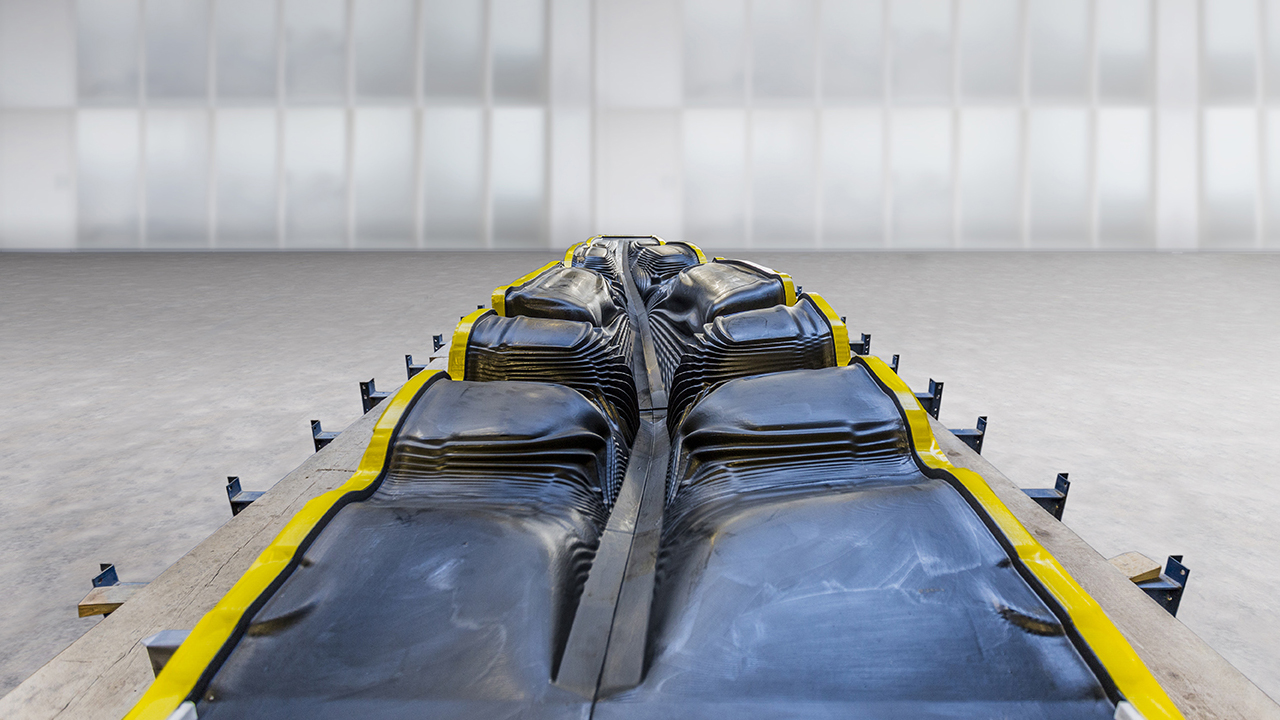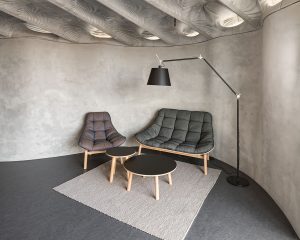IN THE LATE 1980S, WE WITNESSED THE BIRTH OF THE PERSONAL COMPUTER, AND IT DIDN’T TAKE LONG FOR PERSONAL PRINTER TO BECOME A MUST HAVE HOUSEHOLD TOOL. 3-D PRINTING TECHNOLOGY TODAY SEEMS TO BE GOING ALONG THE SAME ROUTE
TEXT: KANOKWAN TRAKULYINGCHAROEN
MAIN IMAGE AND PHOTO: © DIGITAL BUILDING TECHNOLOGIES (DBT), ETH ZÜRICH
/ ANDREI JIPA EXCEPTED AS NOTED
(For English, please scroll down)
ในปลายทศวรรษ 1980 เราได้เห็นการเกิดขึ้นของคอมพิวเตอร์ส่วนบุคคลและจากนั้นอีกไม่นานปริ้นเตอร์ส่วนบุคคลก็เข้ามาเคาะประตูบ้านคนทั่วไป วันนี้สิ่งที่กำลังเกิดขึ้นกับเทคโนโลยี 3-D printing ก็ดูจะไม่แตกต่างกันมากนัก คอนเซ็ปต์พื้นฐานของเทคโนโลยีตัวนี้คือ การขึ้นรูปสามมิติโดยอาศัยการเพิ่มชั้นระนาบของวัสดุเข้าไป (additive manufacturing) เมื่อสี่ห้าปีที่แล้ว การค้นคว้าทดลองเรื่องนี้แตกประเด็นออกเป็นสองเรื่องใหญ่คือ สเกลของตัวชิ้นงานที่สร้างโดยเทคโนโลยี 3-D printing กับวัสดุที่เราสามารถนำมาปรับใช้ได้กับเทคโนโลยีตัวนี้ ซึ่งเมื่อเดือนกรกฎาคมปีที่แล้วบทความ “The 3-D Printing Playbook” ใน Harvard Business Review ก็สรุปสถานะล่าสุดของ 3-D Printing ออกมาให้ผู้อ่านวงนอกที่เป็นระดับผู้บริหารได้เห็นว่า เทคโนโลยีตัวนี้ทำให้เกิด business models ใหม่ๆ อะไรบ้างสำหรับตลาดโลกในวงกว้าง ไม่ว่าจะเป็นเรื่องของ Mass Customization ที่นำไปสู่การลดต้นทุนในการเก็บข้อมูลที่ลงลึกเกี่ยวกับตัวผู้บริโภคเพราะผู้บริโภคยินดีที่จะให้ข้อมูลตนเองเพื่อเข้ารับบริการหรือใช้ผลิตภัณฑ์แบบใหม่ Mass Variety ที่นำไปสู่วิธีการแบบใหม่ในการจัดการตัวเลือกที่ไม่มากจนตาลายสำหรับผู้บริโภคหรือ Mass Segmentation ที่นำไปสู่การแบ่ง segment รูปแบบใหม่ในตลาด เป็นต้น และก็เหมือนเป็นการตอกย้ำอยู่ในทีว่า อีกไม่นานเราจะคุ้นเคยกับเทคโนโลยีนี้จนแทบจะนึกไม่ออกเลยว่า ครั้งหนึ่งมันเคยเป็นเรื่องที่ดูไกลตัวเรามากขนาดไหน

The structural ribs of the Smart Slab
ถึงแม้ว่าเทคโนโลยี 3-D Printing ที่เราเห็นมากมายในสื่อต่างๆ ในปัจจุบันนั้น แตกยอดออกมาจากกระบวนการพิมพ์ขึ้นรูปได้หลักๆ ทั้งหมด 7 แบบ ซึ่งจะมีความแตกต่างกันไปตามหลักการในการสร้างเลเยอร์แต่ละชั้น กับวิธีการซ้อนทับของการพิมพ์แต่ละเลเยอร์ ถ้าเราโฟกัสกันในส่วนของเทคโนโลยี 3-D Printing เพื่อใช้ในงานสถาปัตยกรรม เราจะเห็นว่าผลงานส่วนใหญ่ที่เราได้เห็นผ่านตาในช่วงสิบปีที่ผ่านมานี้ ส่วนใหญ่แล้วใช้เทคนิคกระบวนการพิมพ์ขึ้นรูปอยู่เพียง 2 แบบ แบบแรก คือ การอัดวัสดุขึ้นรูป (Material Extrusion) และแบบที่สอง การพ่นตัวเชื่อมในถาดผงวัสดุ (Binder Jetting)

Post-processing of the 3D printed formwork parts | © Digital Building Technologies (dbt), ETH Zürich / Tom Mundy
การอัดวัสดุขึ้นรูป (Material Extrusion) น่าจะเป็นแบบที่เราได้มีโอกาสเห็นบ่อยที่สุด ในข่าวบ้านคอนกรีตต้นแบบที่สร้างด้วยเทคโนโลยี 3-D Printing เป็นภาพของแขนกลเหล็กขนาดใหญ่ที่ปลายแขนมีหัวฉีดที่ใช้พ่นเนื้อคอนกรีตที่มีความเหนียวและคงตัวระดับหนึ่งออกมา อย่างเช่นที่เห็นกันในเทคโนโลยี 3-D Printing ของ XtreeE และ Machines-3D Constructor จากฝรั่งเศส, MIT Digital Construction Platform จากสหรัฐอเมริกา, dfab จากสวิตเซอร์แลนด์หรือเทคโนโลยี 3-D Printing ที่ใช้ระบบโครงเหล็กเสา-คานวางบนราง โดยหัวฉีดจะติดตั้งอยู่บนคานที่สามารถขยับไปมาได้ทั้งในแนวราบและแนวตั้งแบบเดียวกับที่เห็นได้ในเครื่องพิมพ์ของ Contour Crafting จากสหรัฐอเมริกา, BIG 3D Printer 2156 จากสวิตเซอร์แลนด์และ DUS Architects จากเนเธอร์แลนด์
ในขณะที่แบบแรกมีการใช้งานอย่างแพร่หลายและกลายเป็นเทคโนโลยีหลักที่หลายบริษัทชั้นนำทางด้านนี้ของโลกเลือกใช้เป็นส่วนหนึ่งของการให้บริการในลักษณะ Printing Solution กระบวนการแบบที่สอง เป็นการพ่นตัวเชื่อมลงในถาดวัสดุแบบผง (Binder Jetting) โดยจะมีขั้นตอนการเตรียมผงซีเมนต์ที่ทำจากส่วนผสมหลักอีกสองตัวคือทรายกับแมกนีเซียมลงในถาดขนาดใหญ่ จากนั้นลูกกลิ้งจะทำหน้าที่เกลี่ยปรับระดับผงวัสดุ ก่อนที่คานที่ติดตั้งหัวฉีดจะพ่นสารละลายที่เป็นตัวเชื่อมเม็ดผงวัสดุเข้าด้วยกันที่ละชั้นซ้อนกันไปเรื่อยๆ อย่างเช่นในเทคโนโลยี 3-D Printing ของ D-Shape จากอิตาลี และ dfab จากสวิตเซอร์แลนด์
อ่านฉบับเต็มได้ใน art4d No.266


© NCCR Digital Fabrication / Michael Lyrenmann
In the late 1980s, we witnessed the birth of the personal computer, and it didn’t take long for personal printer to become a must have household tool. 3-D printing technology today seems to be going along the same route. The fundamental concept of technology is the formation of three-dimensional form using an additive manufacturing process.

Four to five years ago, the main focuses of the experiments in the field were divided into two different aspects. The first was the scale of the work created using 3-D printing technology and the other is the development of possible materials that can be applied to the technology. In July last year, the article “The 3-D Printing Playbook” in the Harvard Business Review concludes the state of the art of the technology. Especially for readers who aren’t a part of the industry, including those who are in the executive level, it demonstrates how the technology has conceived new business models for a wider global market. Such models include things like Mass Customization, that leads to the cost reduction for more personalized products. This is especially relevant with the consumers’ data that is willingly given by the consumers themselves in exchange for early access to new products and services. Mass Variety leads to new methods which render the more refined alternatives for consumers whereas Mass Segmentation enables new ways in which market segments are reorganized. Overall, the update is another emphasis of how technology will become an integral part of our lives to the point where we may forget how irrelevant we once used to feel about it.

The 3D sand printer | © Digital Building Technologies (dbt), ETH Zürich / Tom Mundy
While 3-D printing technology is heavily covered by the media, it has expanded into main 7 processes, each different in principle. It begins with layer formation and the superimposition of printed layers. To exclusively look at the 3-D Printing technology for architecture, we’ve witnessed, at least in the past ten years, primarily two types of processes; Material Extrusion and Binder Jetting.
Photo: Roman Keller
Material Extrusion is probably the most common process especially in the news about the prototype of 3D printed concrete homes with an image of a massive mechanical arm with a nozzle, that releases concrete mixture with the exact level of build-ability. A similar process can be witnessed from 3D printing technology developed by XtreeE and Machines-3D Constructor from France, and dfab from Switzerland. There also the 3D printing technology, which utilizes the use of the steel beam and column structure installed in a rail. This allows the nozzles to move vertically and horizontally. Such a method is used by Contour Crafting technique from the United States as well as Switzerland’s BIG 3D-Printer 2156 and by DUS architecture from the Netherlands.
Material Extrusion has been widely adopted and has become a principal technology utilized by several of the world’s leading companies with 3D-printing expertise. The second printing solution or Binder Jetting, on the other hand, requires a preparation method where the sand-magnesium based cement powder is mixed is a massive tray. The roller then starts spreading out the ingredients evenly before a liquid binding is jetted and deposited itself to join powder particles, gradually bonding the layers of materials to form an object. One of the few pratices that employ Binder Jetting technology for architecture and construction Italy’s D-Shape and dfab from Switzerland.
Read the full article in art4d No.266



